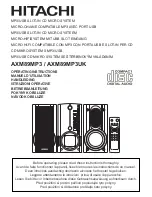
1 – Internal Effects on the DM-24—Effect send sources
TASCAM DM-24 Effects
5
Example 2 (Loop/insert setting with 1 & 2
both = stereo input)
In this example, both
effects are used in insert mode. Busses 1 and 2 use a
effect 1 as a stereo phaser (this can be turned on or
off as needed for a creative effect).
The stereo compressor assigned to effect 2 is inserted
in the stereo output buss in order to limit the dynamic
range of the stereo outputs.
Example 3: (Loop/insert setting with 1 &
2 both = mono input)
Here again, both effect 1
and effect 2 are used as inserts, but they both have
mono inputs.
Effect 1 (a distortion setting) is being used with a dis-
tortion effect, in order to achieve a distorted vocal
sound.
Effect 2 (a chorus) is inserted into an input channel
(for example, a fretless bass) in order to thicken the
sound. In this example, because these effects are
being used by only one channel each, there is no need
to tie up the aux sends and returns, which can then be
used for other purposes.
Example 4: 1/2 series (1=mono input,
2=stereo input)
In this example, the two effects
are put in series, with effect 1 (echo) taking a mono
mic signal and echoing it to the left and right chan-
nels.
These echoes are then passed to the reverb, where
they are processed “in-place” to provide an interest-
ing stereo effect (note that reversing these two effects
would produce echoed reverb—probably less desir-
able).
Effect send sources
Whether the effect (or in series mode, both effects
together) is used as a loop or an insert depends on the
source selected for the effect inputs.
Aux 1 through 6
When these are selected as
effect input sources, the effect is placed in a loop.
The effect output with this setting is assigned to a
channel using the I/O screens (see “Signal sources”
on page 36 of the main manual).
If a channel has already been assigned to take its
input from an internal effect, this channel is shown
Содержание DM-24
Страница 1: ...DM 24 Digital Mixing Console to EFFECTS MANUAL...
Страница 31: ......






































